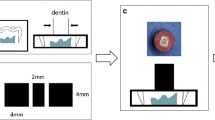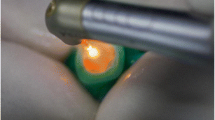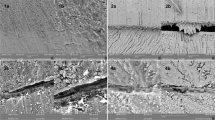Abstract
This study tested if dentin adhesion is affected by Er:YAG laser. Ninety dentin disks were divided in groups (n = 10): G1, control; G2, Er:YAG laser 150 mJ, 90° contact, 38.8 J/cm2; G3, Er:YAG laser 70 mJ, 90° contact, 18.1 J/cm2; G4, Er:YAG laser 150 mJ, 90° non-contact, 1.44 J/cm2; G5, Er:YAG laser 70 mJ, 90° non-contact, 0.67 J/cm2; G6, Er:YAG laser 150 mJ, 45° contact, 37.5 J/cm2; G7, Er:YAG laser 70 mJ, 45° contact, 17.5 J/cm2; G8, Er:YAG laser 150 mJ, 45° non-contact, 1.55 J/cm2; and G9, Er:YAG laser 70 mJ, 45° non-contact, 0.72 J/cm2. Bonding procedures were carried out and the micro-shear-bond strength (MSBS) test was performed. The adhesive surfaces were analyzed under SEM. Two-way ANOVA and multiple comparison tests revealed that MSBS was significantly influenced by the laser irradiation (p < 0.05). Mean values (MPa) of the MSBS test were: G1 (44.97 ± 6.36), G2 (23.83 ± 2.46), G3 (30.26 ± 2.57), G4 (35.29 ± 3.74), G5 (41.90 ± 4.95), G6 (27.48 ± 2.11), G7 (34.61 ± 2.91), G8 (37.16 ± 1.96), and G9 (41.74 ± 1.60). It was concluded that the Er:YAG laser can constitute an alternative tool for dentin treatment before bonding procedures.



Similar content being viewed by others
Notes
The energy delivered at the end of the tip was measured with a power meter (FieldMaster, Coherent, USA) before the laser irradiation.
References
Pashley DH (1990) Interaction of dental materials with dentin. Trans Acad Dent Mat 3:55–73
Degrange M, Attal JP, Theimer K et al (1993) In vitro tests of dentin bonding systems. In: Vanherle G, Degrange M, Willems G (eds) State of the art on direct posterior filling materials and dentin bonding. Van der Poorten, Belgium, pp 205–225
Yoshiyama M, Carvalho R, Sano H, Horner JA, Brewer PD, Pashley DH (1996) Regional bond strengths of resins to human root dentin. J Dent 24:435–442
Prati C, Chersoni S, Mongiorgi R, Pashley DH (1998) Resin-infiltrated dentin layer formation of new bonding systems. Oper Dent 23:185–194
Buonocore MG (1995) A simple method of increasing the adhesion of acrylic filling materials to enamel surfaces. J Dent Res 34:849–853
Hibst R (2002) Lasers for caries removal and cavity preparation: state of the art and future directions. J Oral Laser Appl 2:203–212
Hibst R, Keller U (1989) Experimental studies of the application of the ER:YAG laser on the dental hard substances: I measurement of the ablation rate. Lasers Surg Med 9:338–344
Keller U, Hibst R (1989) Experimental studies of the application of the Er:YAG laser on the dental hard substances: II light microscopic and SEM investigations. Lasers Surg Med 9:345–351
Hossain M, Nakamura Y, Yamada Y, Kimura Y, Nakamura G, Matsumoto K (1999) Ablation depths and morphological changes in human enamel and dentin after Er:YAG laser irradiation with or without water mist. J Clin Laser Med Sur 17:105–109
Visuri SR, Gilbert JL, Wright DD, Wigdor HA, Walsh JT Jr (1996) Shear strength of composite bonded to Er:YAG laser-prepared dentin. J Dent Res 75:599–605
Niu W, Eto J, Kimura Y, Takeda FH, Matsumoto K (1998) A study on microleakage after resin filling of Class V cavities prepared by Er:YAG laser. J Clin Laser Med Sur 16:227–231
Wright GZ, McConnel RJ, Keller U (1993) Microleakage of Class V composite restorations prepared conventionally with those prepared with an Er:YAG laser: a pilot study. Pediatr Dent 15:425–426
Aoki A, Ishikawa I, Yamada T, Otsuki M, Watanabe H, Tagami J, Ando Y, Yamamoto H (1998) Comparison between Er:YAG laser and conventional technique for root caries treatment in vitro. J Dent Res 77:1404–1441
Ceballos L, Toledano M, Osorio R, Tay FR, Marshall GW (2002) Bonding to Er–YAG-laser-treated dentin. J Dent Res 8:119–122
Matsumoto K, Hossain M, Tsuzuki N, Yamada Y (2003) Morphological and compositional changes of human dentin after Er:YAG laser irradiation. J Oral Laser Appl 3:15–20
Giachetti L, Russo DS, Scarpelli F, Vitale M (2004) SEM analysis of dentin treated with the Er:YAG laser: a pilot study of the consequences resulting from laser use on adhesion mechanisms. J Clin Laser Med Sur 22:35–41
Shimada Y, Antonucci JM, Schumacher GE et al (1999) Effects of regional tooth structure and sectioning orientation on micro-shear bond strength. In: Tagami J, Toledano M, Prati C (eds) Advanced adhesive dentistry, International Kuraray Symposium, Tokyo, pp 91–103
Shimada Y, Kikushima D, Tagami J (2002) Micro-shear bond strength of resin-bonding systems to cervical enamel. Am J Dent 15:373–377
Toledano M, Osório R, Leonardi G, Rosales-Leal JI, Ceballos L, Cabrerizo-Vilchez MA (2001) Influence of self-etching primer on the resin adhesion to enamel and dentin. Am J Dent 14:205–210
Nakabayashi N, Pashley DH (2000) Hybridization of dental hard tissues, Quintessence, Tokyo
Nakabayashi N (1991) Dentinal bonding mechanisms. Quintessence Int 22:73–74
Kataumi M, Nakajima M, Yamada T, Tagami J (1998) Tensile bond strength and SEM evaluation of Er:YAG laser irradiated dentin using dentin adhesive. Dent Mat J 17:125–138
Armengol V, Jean A, Weiss P, Hamel H (1999) Comparative in vitro study of the bond strength of composite to enamel and dentin obtained with laser irradiation or acid etch. Lasers Med Sci 14:207–215
Martínez-Insua A, Dominguez LS, Rivera FG, Santana-Penin UA (2000) Differences on bonding to acid-etched or Er:YAG-laser-treated enamel and dentin surfaces. J Prosthet Dent 84:280–288
Eguro T, Maeda T, Otsuki M, Nishimura Y, Katsumi I, Tanaka H (2002) Adhesion of Er:YAG laser-irradiated dentin and composite resins: application of various treatments on irradiated surface. Lasers Surg Med 30:267–272
Benazzato P, Stefani A (2003) The effect of Er:YAG laser treatment on dentin collagen: an SEM investigation. J Oral Laser Appl 3:79–81
Schein MT, Bocangel JS, Nogueira GEC, Schein PAL (2003) SEM evaluation of the interaction pattern between dentin and resin after cavity preparation using Er:YAG laser. J Dent 31:127–135
Torii Y, Itou K, Nishitani Y, Ishikawa K, Suzuki K (2002) Effect of phosphoric acid etching prior to self-etching primer application on adhesion of resin composite to enamel and dentin. Am J Dent 15:305–308
Hossain M, Nakamura Y, Kimura Y, Yamada Y, Ito M, Matsumoto K (2000) Caries-preventive effect of Er:YAG laser irradiation with or without water mist. J Clin Laser Med Sur 18:61–65
Perdigão J, Lambrechts P, Van Meerbeek B, Tomé AR, Vanherle G, Lopes AB (1996) Morphological field emission–SEM study of the effect of six phosphoric acid etching agents on human dentin. Dent Mat 12:262–271
Ceballos L, Osorio R, Toledano M, Marshall GW (2001) Microleakage of composite restorations after acid or Er:YAG laser cavity treatments. Dent Mater 17:340–346
Acknowledgment
The authors would like to express their gratitude to the Tokyo Medical and Dental University and to the Committee of International Cooperation of the University of São Paulo (CCInt/USP) for making the present study feasible. In addition, we would like to thank the Kuraray (Japan), Kota (Brazil), and the State of São Paulo Research Foundation / FAPESP (São Paulo, Brazil).
Author information
Authors and Affiliations
Corresponding author
Rights and permissions
About this article
Cite this article
de Carvalho, R.C.R., de Freitas, P.M., Otsuki, M. et al. Micro-shear bond strength of Er:YAG-laser-treated dentin. Lasers Med Sci 23, 117–124 (2008). https://doi.org/10.1007/s10103-006-0434-6
Received:
Accepted:
Published:
Issue Date:
DOI: https://doi.org/10.1007/s10103-006-0434-6




